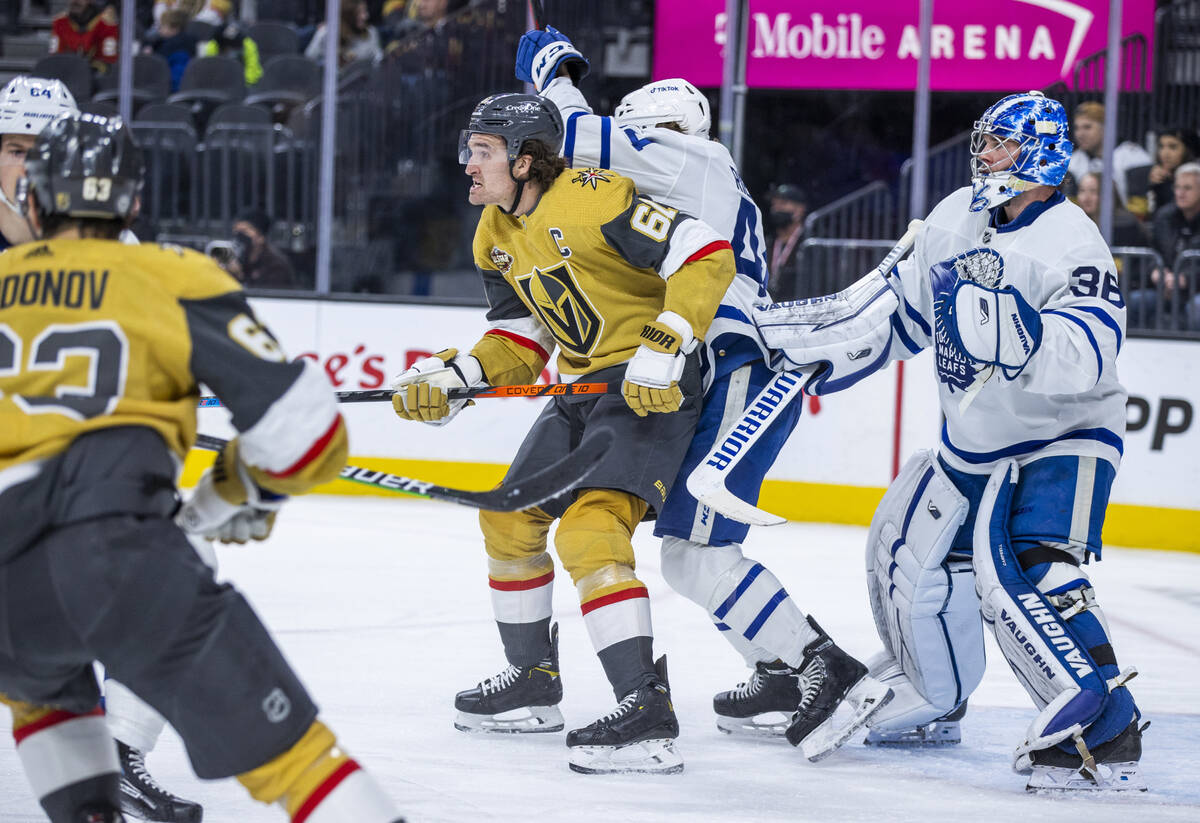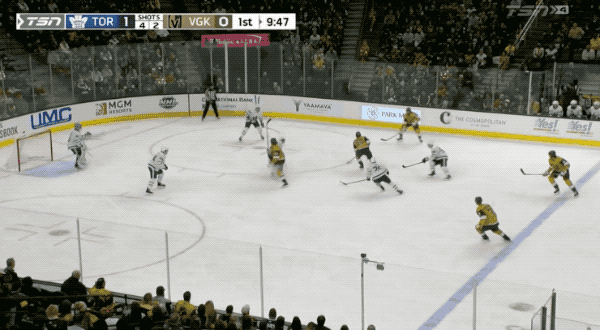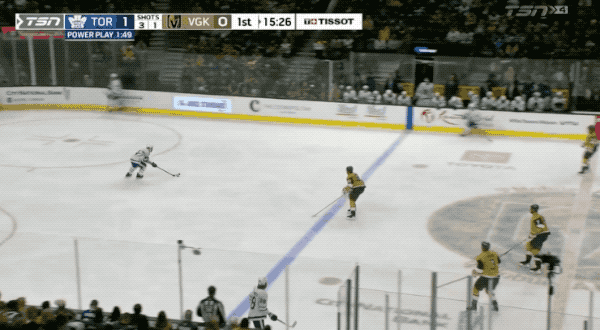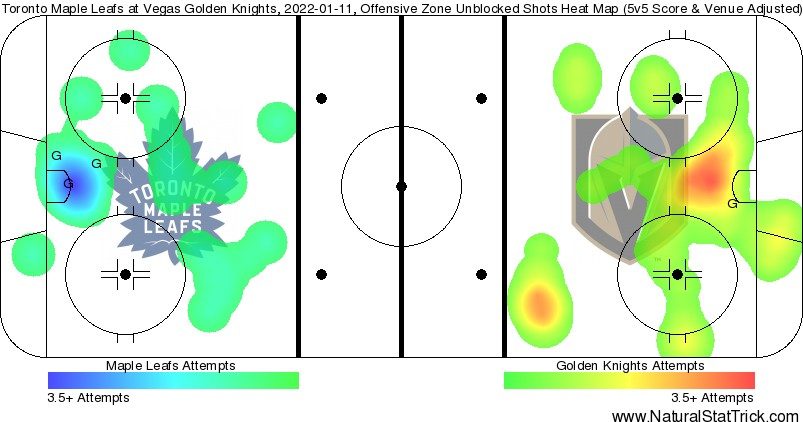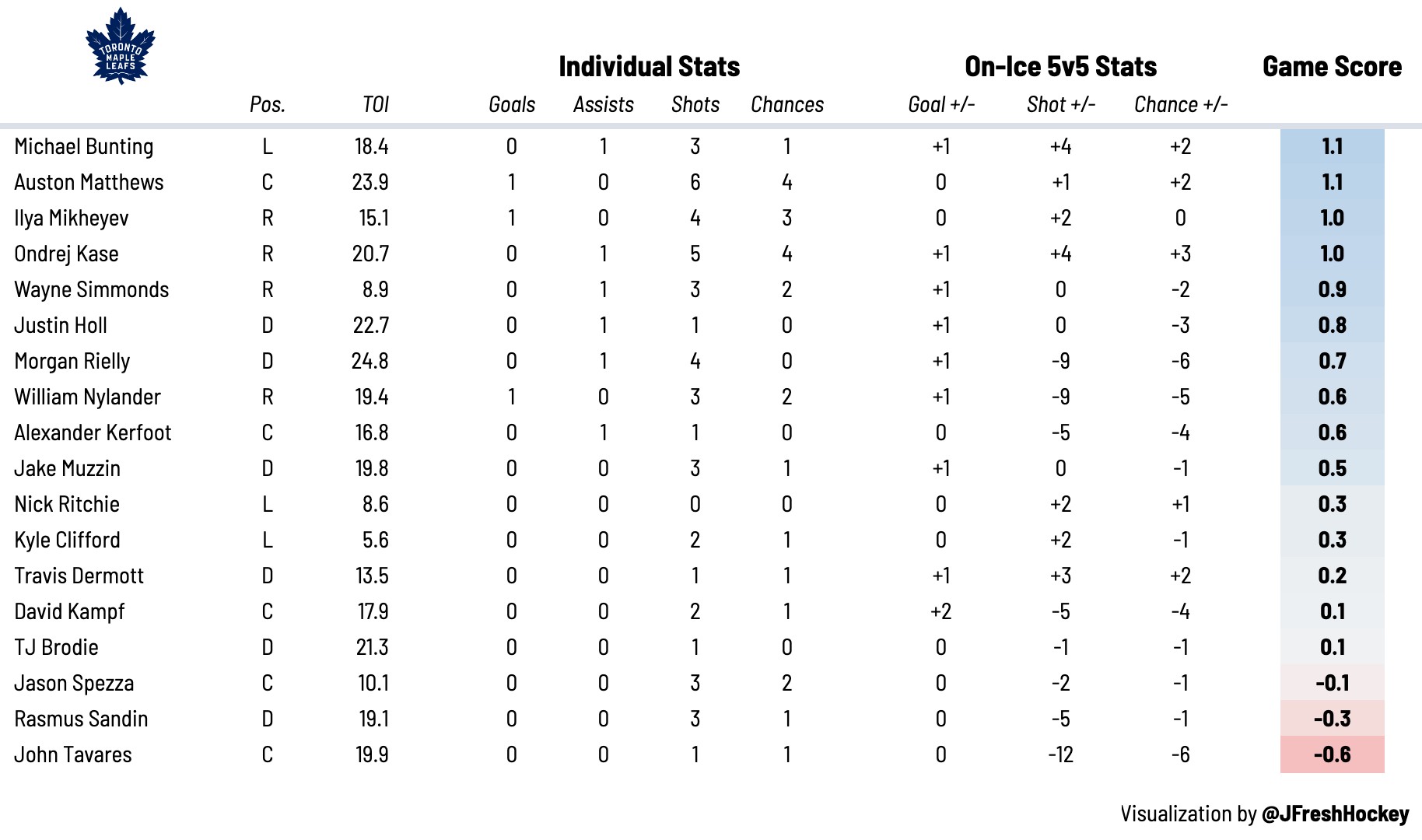Did you stay up for this one?
You may have some regrets this morning.
Toronto came out of the gates on fire, spending nearly 10 minutes of the opening frame with possession in Vegas’ end. That’s an absurd amount of time for only one period of play.
They followed that up with a truly terrible second period, getting drastically outplayed yet somehow outscoring their opponent because hockey is a game of randomness. With a 3-1 lead heading into the third period, the Leafs tried their best to slow things down.
It didn’t work.
Vegas eventually tied the game 3-3 thanks to a great soccer assist from Reilly Smith and a 5-on-3 power-play goal by Alex Pietrangelo. What’s unfortunate is that Toronto only registered nine shots on goal in the final 45 minutes of this game.
Again, staying up until past midnight was the wrong decision. Those of us who did will be performing less optimally on Wednesday because we insisted on watching a Leafs team steal two points in the shootout of a game they did not deserve to win.
That’s hockey for you! There are some positives to take out of this game, along with some very glaring negatives, but we’ll start our player evaluations on the bright side of things. Keep chugging that caffeine, folks, it’s time for some Leafs Report Cards!
5 Stars
The Bunting-Matthews-Kase Line
We’re only dealing with a 43-minute sample here, but this line has been crushing it at 5v5, controlling 58 percent of the total shots and 60 percent of the scoring chances. The MVP candidate centering Toronto’s first line is obviously the major driving force behind these results, but his complementary wingers deserve some credit, too.
Coming into the season, the one thing we knew about Michael Bunting is that he was a pest who could win battles and drive hard to the net. I don’t think any of us expected him to become a playmaker in the top six.
This has been my favourite attribute in Bunting’s game: his ability to complete passes off the rush. It’s one of the most predictive elements of future point production, which helps explain why he’s racked up so many points this year.
Plays aren’t dying on his stick in transition. He’s able to keep passing sequences going at high speeds, getting the puck to skilled players in open space. Even off the cycle, Bunting has much better vision than you’d expect given his reputation. His one-touch pass to a wide-open Matthews for a tap-in goal is a great example of that.
We should probably also bring up Ondrej Kase, who’s also been one of the best bargains in the NHL. He and Bunting combine for $2.2 million — less than Nick Ritchie — and are proving to be effective forwards that can produce at a top-six rate.
They do it in different ways. While Bunting makes shifty little passes in transition, Kase uses his explosiveness to blow by his man in the neutral zone and create separation off the rush. From there, he kamikazes his way to the net and generates tons of scoring chances from the slot.
That aggressiveness can get him in trouble sometimes (i.e. turning the puck over on an overzealous zone entry attempt, leading to a rush chance the other way). With risk, however, comes reward (i.e. earning himself a couple of breakaways against Vegas). Kase also made a great no-look feed to Bunting right before the Matthews goal, completing a pass out front from below the goal-line.
Last but not least, we should probably mention the guy who’s on pace to score 60 goals and get some serious consideration for the Selke.
Goals-wise, this has been Auston Matthews' best start to a season through 30 games. pic.twitter.com/troX9k1paa
— Mark Norman (@MNorman87) January 12, 2022
We’re running out of words to describe Auston Matthews‘ ascension to superstardom, which makes him a difficult player to evaluate night in and night out.
It’s reached the point where we expect him to dance his way around defenders and fire pucks towards the net like a machine gun, so I’m left wondering if I should even mention the fact that he attempted six shots against the Golden Knights, four of which came from the slot.
He’s become so dominant in the full 200-feet of the ice that I find myself trying to find aspects where he can improve, which is a tough task for a player who’s currently leading the league in Wins Above Replacement (WAR).
One aspect that’s stood out to me is how much he defers on power play entries.
The true superstars in this league take the puck on a drop pass and find a way to gain the zone, whether it’s Connor McDavid, Nathan MacKinnon, Nikita Kucherov — you name it. Matthews has often deferred to Mitch Marner in these instances throughout his career, and in this instance, he tried to get Kase the puck instead of dictating play himself.
When you have Matthews’ combination of size, skill, and now speed this year, you need to be a bit more selfish as a puck-carrier. I’d love to see him demand the puck at 5v4 and force his way into the offensive zone the way Mario Lemieux or Jaromir Jagr did in their primes. He’s that type of talent, and I still think there’s another gear he can reach when it comes to these zone entries.
William Nylander (RW, #88) — Guess who leads the league in breakaways? I checked with Mike Kelly to be sure and he confirmed what you already know: it’s William Nylander.
Smooth stuff, Styles 😎🥵#LeafsForever pic.twitter.com/NEMmZPw8hc
— Toronto Maple Leafs (@MapleLeafs) January 12, 2022
He’s been doing this all year. What I love is that he isn’t “cheating” for offense on these plays. Nylander sees the breakout happening before the opponent’s last man back, which gives him a chance to pick up speed and dart up ice into the open space.
There were some other noteworthy high-skilled plays in this game, including a crafty slot pass to John Tavares on the power play, not to mention the game-winning shootout goal. Personally, though, I’d rather just wax poetic on Nylander’s ability to generate so many breakaways. It’s the one thing in hockey teams don’t want to give up and he’s consistently able to get behind opposing defenses with his speed, both in terms of how quickly he thinks the game and plays it.
4 Stars
The Rielly-Brodie “Shutdown” Pair
Do yourself a favour and watch that Nylander breakaway goal one more time. Morgan Rielly makes a brilliant pass in the neutral zone to spring Nylander. Like we were saying with Bunting, completing those passes in transition are so valuable because they lead to high-percentage offense.
We’ve grown accustomed to watching Rielly beat his man out of the defensive zone on the breakout and generate offense off the rush, but it’s been his play without the puck that’s really stood out this season. He’s not allowing nearly as many chances from the slot in 2021-22, using his speed to get back and kill odd-man rushes (i.e. recovering on a Tavares blunder to stick-lift Evgeni Dadonov on a breakaway). Rielly also made a great play to get down on one knee and prevent a pass through the slot at the end of a long shift.
That’s something we’re usually more used to seeing from TJ Brodie, who was (once again) fantastic defensively. I’ve said this before, but watching him closely over the past 90 games in a Leafs uniform has helped teach me a lot about defending effectively in the modern game. He uses his mobility to close the gap in transition, taking away space from opposing forwards after they cross the blueline without overcommitting and getting burned.
Young defensemen could learn a lot about defending the rush by watching Brodie footage. There are other great examples out there, including MacKenzie Weegar or Jonas Brodin, but given the spotlight that’s on him in Toronto, I’d highly encourage youth hockey coaches to show their defensemen more clips of #78 in blue and white. He’s a treat to watch defend in transition.
3 Stars
Justin Holl (RD, #3) — Ready for a hot take? I thought Justin Holl played alright. He definitely bobbled a few pucks that he shouldn’t have, but he also defended the rush very well, gapping up at the blueline and preventing the opposition from generating chances in transition with speed.
Everyone tends to pile on defensemen after a goal against, but I thought he made the right play on the PK by forcing the opposing forward wide and around the net. It was Jake Muzzin who took himself out of position and Jack Campbell who should’ve held himself tighter to the post on Vegas’ first goal.
Jack Campbell (G, #36) — Yes, that first goal was a bit soft, and yes, Campbell allowed three goals in this game. With that in mind, I have trouble justifying an above-average grade for the netminder, although it was his play in the final two-thirds of the game — particularly his second period — that kept Toronto in it.
This didn’t feel like a game that Campbell outright “stole” for Toronto; there were fortuitous bounces for them in the second period lifting them to greater heights than they had earned as well.
Alex Kerfoot (LW, #15) — I’ll save my large sample thoughts on Kerfoot for another day. When it comes to his performance in this game, I didn’t love him at 5v5 but absolutely loved him at 4v5. He does such a great job at using his speed to clog up the neutral zone on the PK, which makes it difficult for opposing puck carriers to gain the zone. That’s the most important part of a successful power play and Kerfoot made sure Vegas wasn’t gaining clean entry on his side of the ice.
At even strength, I would have liked to see Kerfoot be a bit stronger in puck battles, particularly when he and Rielly had Smith outnumbered and still couldn’t dig the puck out. It’s just one play, but it’s a major area of weakness in his game that will only be magnified when the Ben Chariots of the world are allowed to be more physical in the playoffs.
One positive we should note is that Kerfoot immediately provided a playmaking element to the Mikheyev-Kampf line in the third period when Sheldon Keefe shifted the lines around. Kerfoot’s presence immediately opened up the ice with side-to-side puck-movement, giving his linemates more room to use their speed to attack up the ice and actually create some offense off the rush.
Jason Spezza (C, #19) — The fourth line was a disaster in this one. How much of that was Spezza’s fault? I would argue not much of it. He was trying to get things going in transition, swinging back and darting up the ice with speed. The problem is that he didn’t have anyone to play off of in the neutral zone, which clogged up all the space and effectively killed any chance he had of creating any dangerous offense.
Travis Dermott (RD, #37) — I don’t have too much to say here, other than the fact that Dermott drew a penalty in his own end on a puck retrieval and made a great recovery to prevent a breakaway in this game. Otherwise, it was a pretty simple but effective night for the third pairing defender.
The Mikheyev-Kampf-Simmonds Line
Considering the fact that Mikheyev-Engvall-Simmonds was an effective line for Toronto last season — controlling 57 percent of scoring chances in 230 minutes together at 5v5 in 2020-21 — it makes sense that Sheldon Keefe would give this trio a look. They scored a goal and came out even in the possession share, although the three forwards struggled to connect on passes in the neutral zone, essentially hit a wall at points once they got the puck out of the defensive zone.
Wayne Simmonds had a few big crunches in the corner and battled hard for rebounds in the offensive zone, but struggled at times with the puck on his stick. David Kampf was solid defensively, as always, and pretty quiet offensively, as always. Ilya Mikheyev picked up a goal at the side of the net after a shot missed wide and was otherwise pretty quiet with the puck on his stick.
They would need to complete a few more passing plays for me to believe in the line going forward.
2 Stars
Rasmus Sandin (LD, #38) — By now, I’m sure you’ve seen the clip of him absolutely destroying Dadonov with the Subban-esque hit. Sandin packs quite the punch for someone listed at 178 pounds. By the end of the night, he was credited with 10 hits.
Sandin levels Dadanov #LeafsForever pic.twitter.com/1r9AbSWpuB
— Maple Leafs Hotstove (@LeafsNews) January 12, 2022
That last stat may be misleading — it means he didn’t have the puck much.
Sandin’s puck-moving wasn’t as dynamic from the back-end as we’re used to seeing, although the more concerning aspect to me was how often he was getting beat behind in transition. His gap is usually much better than what we saw in this game, but for whatever reason, he just kept getting walked.
1 Star
John Tavares (C, #91) — Good players have bad games. It’s important to remind ourselves of that — because I’m not quite sure how else to describe Tuesday night for Tavares. When it comes to his turnovers, I’ll try to be nice and say that his first meaningful pass was completed seven minutes into the third period.
This just wasn’t his night.
Jake Muzzin (LD, #8) — It’s getting harder and harder watching Jake Muzzin try to fight the age curve — and the puck. He kept turning it over in the neutral zone, leading to rush chances against and sustained pressure from Vegas. His puck-over-glass penalty wasn’t great, either, although it’s Muzzin’s foot-speed in transition defense that I find more concerning.
Throughout his career, he’s always found a way to prevent zone entries despite not being the most mobile defender in the league. This season, it’s reached the point where conceding the clean entry and forcing the opposing forward wide is a win for Muzzin, which I find worrisome as someone who has always argued he was Toronto’s most valuable defenseman.
That just hasn’t been the case since his last knee injury.
The Fourth Line Wingers — Yikes.
I felt bad for poor Jason Spezza every time he tried to transition the puck up the ice. His linemates, Kyle Clifford and Nick Ritchie, weren’t giving him any help in that department on Tuesday night. Clifford was fumbling pucks seemingly every time in the neutral zone, while Ritchie’s foot speed really slowed down any chance of creating transition offense.
Ritchie also took another dumb penalty, as is tradition. He followed it up with a few big hits in the third period, which was a nice surprise, although I think I speak for all of us when I say it’s time for the Nick Ritchie experiment to end. There are more talented players in the organization than him.
Heat Map
Here’s a quick look at where each team’s shots were coming from at even strength, courtesy of Natural Stat Trick.
The shots were about 50-50, but Vegas had 53 percent of the scoring chances and 55 percent of the expected goals at even strength. Frankly, I’m surprised it wasn’t more lopsided than that.
Game Score
Game score is a metric developed by The Athletic’s Dom Luszczyszyn to measure single-game performance. You can read more about it here.
Tweets of the Night
Things got weird in Florida on Tuesday night, but luckily, it wasn’t as bad as we first thought.
So tired of watching the NHL and thinking somebody scored only to have it overturned after a replay. https://t.co/sHAG8dTRcW
— Down Goes Brown (@DownGoesBrown) January 12, 2022
I don’t know how Down Goes Brown keeps coming up with A+ zingers like these.
never 4get pic.twitter.com/sLQ8x6Kq4Q
— Editor in J (@Account4hockey) January 12, 2022
This was from The Athletic’s Maple Leafs’ fan survey. It’s a good reminder that lot of us were wrong on this one.
The next time smart fans from another fanbase warn you about a player, listen to them. Remember Cody Ceci?
Since the start of the 2019-20 season:
CF%
Matthews with Marner – 54.9
Matthews w/o Marner – 54.2
Marner w/o Matthews – 48.5GF%
Matthews with Marner – 63.1
Matthews w/o Marner – 58.7
Marner w/o Matthews – 38.9— Shawn Ferris (@shawnferris98) January 12, 2022
I’m still not sure how Mitch Marner’s camp managed to negotiate he was in the same stratosphere as Auston Matthews.
It would never happen but
Bunting-Matthews-Kaše
Nylander-Tavares-Marner
Kerfoot-Kämpf-Mikheyev
Engvall-Spezza-Simmonds— Kyle Cushman (@Kyle_Cush) January 12, 2022
Considering the fact that Kerfoot-Tavares-Nylander are below 50 percent in 5v5 shot share, I’d actually love to see the Leafs try something like this.















![John Gruden after the Leafs prospects’ 4-1 win over Montreal: “[Vyacheslav Peksa] looked really comfortable in the net… We wouldn’t have won without him” John Gruden, head coach of the Toronto Marlies](https://mapleleafshotstove.com/wp-content/uploads/2025/09/gruden-post-game-sep-14-218x150.jpg)








